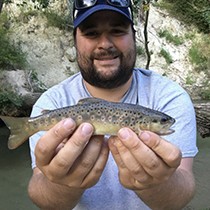M.S. Thesis Defense - Joseph Spooner
Population Demography of a Glacial-Relict Stream Fish Mediated via Anthropogenic Alteration
1:00 pm –
2:00 pm
Hardin Hall
Room: 901 South
Target Audiences:
3310 Holdrege St
Lincoln NE 68583
Lincoln NE 68583
Additional Info: HARH
Contact:
Jonathan Spurgeon, jspurgeon2@unl.edu
Northern Pearl Dace Margariscus nachtriebi are a small-bodied glacial-relict fish species of greatest conservation need (SGCN) found throughout Canada and the northern U.S.A. Their distribution within the Nebraska Sandhills Ecoregion is isolated from the northern core distribution of the species following the last glaciation period approximately 18,000 years ago. Headwater streams within the Nebraska Sandhills Ecoregion are predominately groundwater fed and provide the cool water temperatures needed to support Northern Pearl Dace and other glacial-relict SGCN. Headwater streams within the Nebraska Sandhills Ecoregion have been geomorphically altered through anthropogenic processes such as channelization whereby habitat homogenization has occurred. Evidence of stream habitat changes stemming from channelization directly influencing fish population demographic parameters is limited. Capture-mark-recapture studies used to estimate population demographic parameters may provide insight into the linkages between stream habitat alteration and influences on demographic parameters of fishes. However, limited methods exist to individually mark small-bodied fish <100mm that do not alter behavior or reduce survival of marked individuals. Here, we investigated 1) small-bodied fish survival and tag retention using p-Chip microtransponder tags, and 2) annual survival of Northern Pearl Dace in channelized stream sites within the Nebraska Sandhills Ecoregion. We found tag retention of p-Chip microtransponder tags was high in small-bodied fish and did not affect fish survival. Northern Pearl Dace annual survival significantly differed between channelized stream sites and non-channelized stream sites. These results highlighted the utility of p-Chip microtransponder tags as effective marks for use in small-bodied fish where individual identification is needed. Further, these results indicate channelization may reduce Northern Pearl Dace survival when assuming complete site fidelity. As such, extensive channelization practices within the Nebraska Sandhills Ecoregion may ultimately influence distribution patterns of Northern Pearl Dace populations. Management efforts to increase Northern Pearl Dace populations may benefit from mitigation of channelized streams. Further research assessing spatiotemporal responses of Northern Pearl Dace to channel restoration practices may further refine specific habitat manipulation techniques and spatial distribution of habitat patches needed within watersheds.
Download this event to my calendar
This event originated in SNR Seminars & Discussions.
